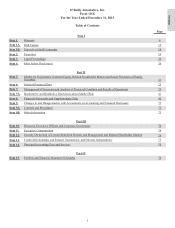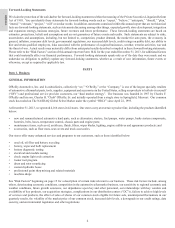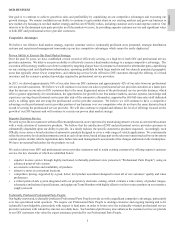O'Reilly Auto Parts 2013 Annual Report Download - page 19
Download and view the complete annual report
Please find page 19 of the 2013 O'Reilly Auto Parts annual report below. You can navigate through the pages in the report by either clicking on the pages listed below, or by using the keyword search tool below to find specific information within the annual report.
FORM 10-K
13
Competition
The sale of automotive aftermarket items is highly competitive in many areas, including customer service, product availability, store
location, brand recognition and price. We compete in both the DIY and professional service provider portions of the automotive aftermarket
and are one of the largest specialty retailers within that market. We compete primarily with the stores identified below:
national retail and wholesale automotive parts chains (such as AutoZone, Inc., Advance Auto Parts, NAPA, CARQUEST and the
Pep Boys - Manny, Moe and Jack, Inc.)
regional retail and wholesale automotive parts chains
independently owned parts stores
wholesalers or jobber stores (some of which are associated with national automotive parts distributors or associations such as NAPA,
CARQUEST, Bumper to Bumper and Auto Value)
automobile dealers
mass merchandisers that carry automotive replacement parts, maintenance items and accessories (such as Wal-Mart Stores, Inc.)
We compete on the basis of customer service, which includes merchandise selection and availability, technical proficiency and helpfulness
of store personnel, price, store layout and convenient and accessible store locations. Our dual market strategy requires significant capital
to support, such as the capital expenditures required for our distribution and store networks and working capital needed to maintain
inventory levels necessary for providing products to both the DIY and professional service provider portions of the automotive aftermarket.
Inflation and Seasonality
We have been successful, in many cases, in reducing the effects of merchandise cost increases principally by taking advantage of vendor
incentive programs, economies of scale resulting from increased volume of purchases and selective forward buying. To the extent our
acquisition costs increase due to base commodity price increases industry wide, we have typically been able to pass along these increased
costs through higher retail prices for the affected products. As a result, we do not believe our operations have been materially, adversely
affected by inflation.
To some extent our business is seasonal, primarily as a result of the impact of weather conditions on customer buying patterns. Store
sales, profits and inventory levels have historically been higher in the second and third quarters (April through September) than in the
first and fourth quarters (October through March) of the year.
Regulations
We are subject to federal, state and local laws and governmental regulations relating to our business, including those related to the handling,
storage and disposal of hazardous substances, the recycling of batteries and used lubricants, and the ownership and operation of real
property.
As part of our operations, we handle hazardous materials in the ordinary course of business and our customers may bring hazardous
materials onto our property in connection with, for example, our oil and battery recycling programs. We currently provide a recycling
program for batteries and the collection of used lubricants at certain stores as a service to our customers pursuant to agreements with
third-party vendors. The batteries and used lubricants are collected by our Team Members, deposited into vendor-supplied containers
and pallets, and then disposed of by the third-party vendors. In general, our agreements with such vendors contain provisions that are
designed to limit our potential liability under applicable environmental regulations for any damage or contamination, which may be
caused by the batteries and lubricants to off-site properties (including as a result of waste disposal) and to our properties, when caused
by the vendor.
Compliance with any such laws and regulations has not had a material adverse effect on our operations to date. However, we cannot
give any assurance that we will not incur significant expenses in the future in order to comply with any such laws or regulations.
EXECUTIVE OFFICERS OF THE REGISTRANT
The following paragraphs discuss information about our executive officers who are not also directors:
Greg Henslee, age 53, President and Chief Executive Officer, has been an O’Reilly Team Member for 29 years. Mr. Henslee’s O’Reilly
career started as a parts specialist, and during his first five years he served in several positions in retail store operations, including district
manager. From there he advanced to Computer Operations Manager, and over the next 15 years, he served as Director of Computer
Operations/Loss Prevention, Vice President of Store Operations and as Senior Vice President. In 1999, he became President of
Merchandise, Distribution, Information Systems and Loss Prevention, and in 2005, he became Chief Executive Officer and Co-President.
























